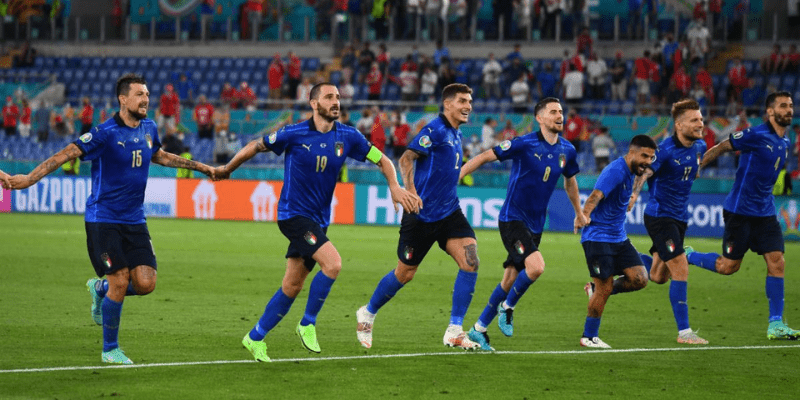When you dig into the archives of the Azzurri, one result stands out—not just as a record, but as a statement. The biggest win in Italy national team history is more than a number: it’s a moment frozen in time. Beneath its face-value dominance, it speaks of a golden age, of oscillating styles, and of the sheer power of an Italian side asserting itself on the world stage. In this article, ZaneyStrike will accompany you to explore that epic victory, the matches that rival it, the context behind it, and the legacy that lingers in Italian football lore.
The Match That Cemented The Record: Italy 11–3 Egypt (1928)

The crown jewel of Italy’s scoring feats came on 9 June 1928, during the Olympic Games in Amsterdam. Facing Egypt in the third-place playoff, Italy unleashed an attacking onslaught, winning 11–3. That match holds the distinction of “most goals scored in a single match” involving Italy, and remains their largest goal tally in any match to date.
Match details and highlights
- At halftime, Italy already led by 6–2, indicating the dominance they imposed early.
- The game was part of the Olympic football tournament’s consolation bracket (third-place playoff).
- It wasn’t part of a world cup or a European championship—this result came in an era when international competitions were still nascent and the Olympics were among the most prestigious global stages. ttps://en.wikipedia.org/wiki/Italy_national_football_team_records_and_statistics?utm_source=chatgpt.com))
This is the only known time Italy has crossed double digits in a match, making the result legendary in its magnitude.
Official Wins vs Unofficial Records: Exploring the Nuances
When football historians talk about “biggest win,” context matters. Does one include friendlies, Olympic matches, or only “official” recognized matches? The answer can shift the record slightly—though not enough to dethrone the 11–3 showing.
Largest “official” victory
In terms of strictly recognized matches under FIFA or national team sanctioning, Italy’s 9–0 win against the United States on 2 August 1948 is frequently cited as their largest official victory.
Meanwhile, some sources list 10–0 vs. United States on 4 April 1975 as the “largest victory,” although that may include less formal or exhibition conditions.
The 11–3 match, while a spectacular scoring display, sits in a grey zone because it occurred in an Olympic framework—which historically sits somewhere between friendly and official in perception.
Comparing apples and oranges: tournament context
- The 11–3 vs. Egypt remains the highest total goals Italy ever scored in a match; even rival triumphs don’t eclipse its sheer volume.
- In official or modern recognized matches, you won’t find Italy scoring more than ten goals.
- This makes the 1928 match not only a statistical outlier but also an enthralling chapter in Italy’s rise as a footballing power.
Rival Contenders: Other High-Scoring Italy Victories
Though none match the 11-goal tally, several other fixtures invite comparison:
| Year / Date | Opponent | Score | Competition | Notes |
| 1948 (Aug 2) | United States | 9–0 | Olympic/official | Often cited as Italy’s largest “official” win |
| 1975 (Apr 4) | United States | 10–0 | Exhibition / non-official | Some sources list as “largest victory” |
| 1934 (May 27) | United States | 7–1 | FIFA World Cup | Italy’s biggest in a World Cup match |
These matches underscore Italy’s capacity to dominate less experienced sides—but only the 1928 performance stretches into “historic masterpiece” territory.
The Context of 1928: Italy’s Football in the 1920s

To understand why Italy achieved such a feat, we must look at their football environment in the 1920s.
Growth of Italian football
- In the 1920s, football in Italy was maturing rapidly. Clubs like Juventus, Inter, Milan, and others were developing more organized professional structures, and the federation was investing in national team identity.
- The Italian team of that era was still building its international reputation; matches such as the Olympics offered rare opportunities to test strength against non-European sides.
Disparities in global football
- At the time, many national teams (especially outside Europe) had less-developed infrastructures, methods, and exposure. Egypt’s football level was strong regionally, but still vulnerable at that time on world tournaments.
- Tactical sophistication, fitness regimes, and travel logistics favored European teams like Italy.
Tactical approach and player quality
- Italy in that era deployed attacking formations like the 2–3–5 “Pyramid,” which prioritized forward play and frequent goals.
- Players of that generation were tactically versatile, accustomed to loose marking and wide-open play, often resulting in high-scoring affairs.
In sum, the 11–3 is partly a product of its time: a clash of footballing maturity, tactical boldness, and a mismatch in competitive balance.
Why That Record Still Matters
Some might dismiss 1928’s numbers as archaic, but the significance endures.
Benchmark of ambition
Even a century later, no Italian side has matched scoring in double digits. That sets a benchmark for offensive ambition and legacy.
Historical lore and national pride
For fans and historians, it’s a touchstone: proof that Italy’s greatness has roots. Modern Italy may win with tight defense and pragmatism, but the 11–3 is a reminder of theatrical football’s capacity.
Educational and statistical gravity
That match remains a data point in every record compendium, a fixture that offers contrast to modern ultra-defensive eras. It’s a narrative anchor for comparisons across eras.
Breaking Down The Numbers: Italy vs Egypt
Let’s peel apart some specifics of that match:
- Italy scored 11 goals, conceding 3, for a goal difference of +8, the largest margin in any match involving Italy.
- That match also accounts as “most total goals in a single match involving Italy.”
- In the head-to-head history, the Italy–Egypt confrontation includes other clashes (for example, 2–1 in 1928 before) but none approach the scale of 11–3.
The sheer volume of goals reflects not just Italy’s attacking dominance but also the defensive vulnerabilities and match tempo of that era.
Legacy, Comparisons & What It Tells Us Today

Modern football and defensive emphasis
In today’s game, such a result is nearly impossible. Defensive formations, pressing, tactical discipline, and parity between teams mean scorelines like 11–3 belong to legend, not recurring patterns.
Comparisons with powerhouses
Even world powers like Brazil, Germany, or Spain rarely exhibit double-digit wins at the highest level. When Italy once matched it (in Olympics), it joined an elite group of nations with that capacity.
Inspirational standard
For young Italians, it’s a story: in the realm of possibility, Italy once destroyed an opponent so completely. It lends aura to the Azzurri legacy beyond trophies.
Conclusion
In this article, ZaneyStrike revisited the legendary biggest win in Italy national team history, the unforgettable 11–3 demolition of Egypt at the 1928 Olympics. That match still towers above all others in goal volume, even if it’s not always treated as the “official” record. With Italy’s largest recognized win (9–0) and other high-scoring fixtures as context, the 11–3 remains a cornerstone of the Azzurri mythos.
Whether you’re chasing statistical trivia, football history, or emotional narratives to share with fellow fans, this result delivers. If you liked this deep dive, stick with ZaneyStrike: we’ll back up with articles on Italy’s greatest comebacks, player profiles. Want us to explore “biggest defeats,” “most capped players,” or “Italy’s World Cup records”? Just say the word—ZaneyStrike has you covered.






